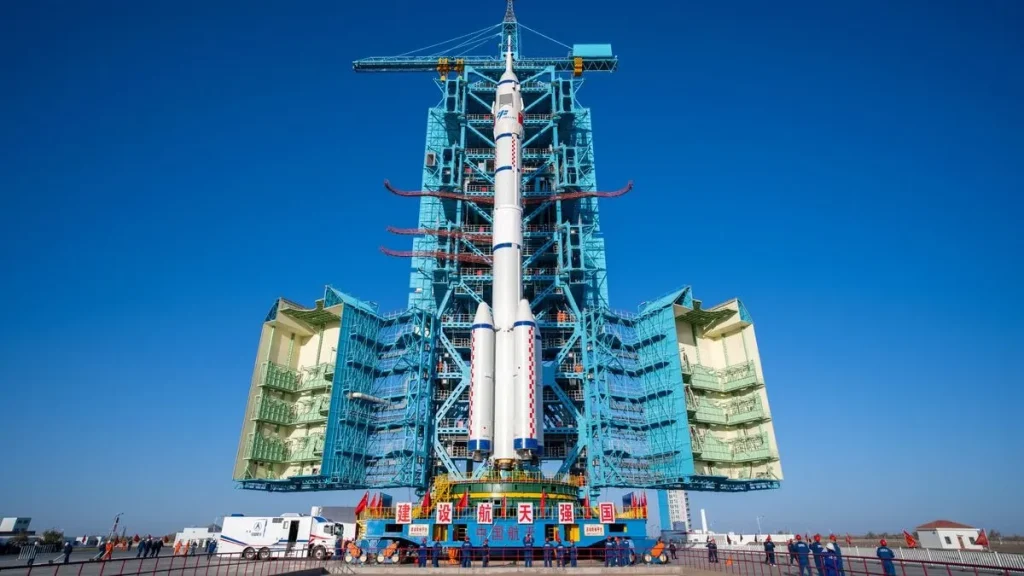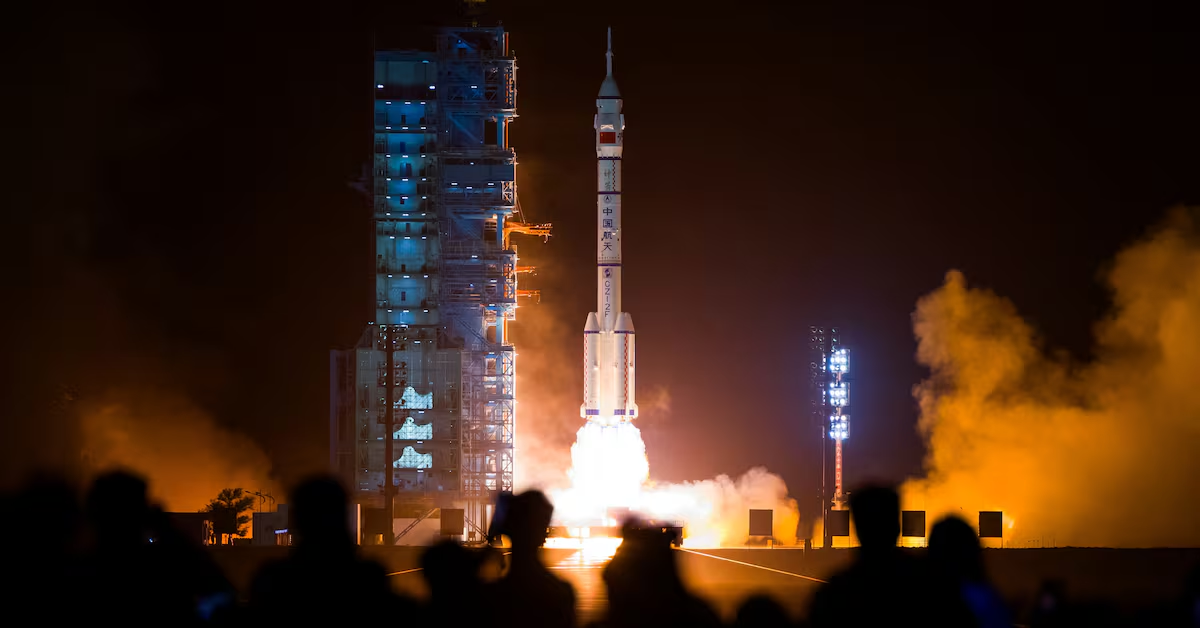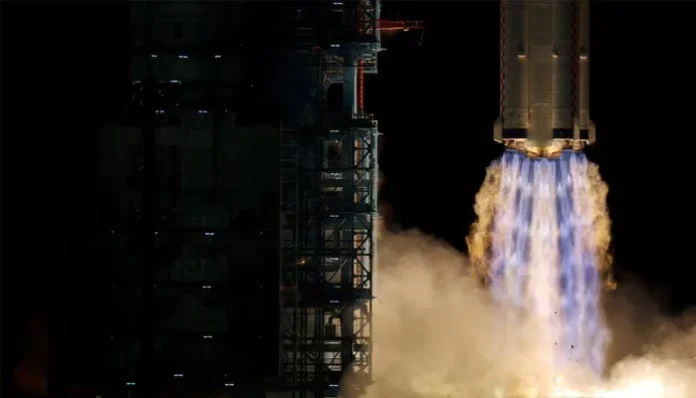Chinese Space Ambitions Soar: Shenzhou 19 Marks a New Era in Exploration.
A Chinese spacecraft, Shenzhou 19, has successfully docked with the Tiangong space station after a journey of over six hours, carrying a three-person crew that includes the country’s first female space engineer, Wang Haoze. This landmark mission marks a significant milestone in Chinese people rapidly advancing space program and showcases the nation’s ambitious plans for the future.
The launch of Shenzhou 19, described by Beijing as a “complete success,” is part of China’s broader strategy to conduct extensive research and experiments in space. The crew will remain at the Tiangong space station for six months, engaging in various scientific experiments and conducting spacewalks. This experience is crucial for Beijing as it prepares for its ambitious goal of sending a human to the Moon by 2030.
The Shenzhou program is a cornerstone of China’s efforts to establish itself as a leading power in space exploration. Earlier this year, Chinese announces plans for a staggering 100 launches, indicating a commitment to furthering its capabilities in space technology.

The launch event at the Jiuquan Satellite Launch Center in Gansu province was a spectacle. The BBC was granted rare access to observe the launch from just over a kilometer away. As the rocket ignited, flames shot from the launcher, lighting up the Gobi Desert and filling the air with a deafening roar. Crowds gathered, waving flags and cheering the taikonauts—China’s term for astronauts—as they embarked on this historic journey.
President Xi Jinping has long championed the idea of space exploration as part of China’s national vision. Just two years ago, he stated that exploring the cosmos and building China into a space power is an “eternal dream.” As China moves forward with its space ambitions, some analysts in Washington perceive this rapid progress as a potential threat, particularly in the context of a new space race between the United States and China.
NASA chief Bill Nelson has publicly acknowledged that the U.S. and China are “in effect, in a race” to return to the Moon. Concerns have been raised regarding China’s intentions in space, with some officials fearing that the country aims to stake territorial claims on lunar resources. The Moon is rich in minerals, including rare earth elements and helium, making it a potential treasure trove for future exploration and exploitation.
In response to these concerns, Li Yingliang, the director of the general technology bureau of China’s Manned Space Agency, dismissed the notion of competition. He emphasized that China’s space program operates on principles of peaceful use and international cooperation. However, the realities of modern geopolitics suggest that the new space race is about much more than just exploration; it’s also about who will control valuable extraterrestrial resources.

The Shenzhou 19 crew is notable not only for its historic inclusion of the first female space engineer but also for its representation of a new generation of Chinese taikonauts. Pilot Cai Xuzhe, a veteran, expressed pride in working alongside younger crew members, highlighting their energy and ambition. Song Lingdong, one of the crew members, recounted how he watched China’s early space missions as a child, which inspired him to pursue a career in aviation.
Their youthful enthusiasm reflects a broader narrative in China’s space program: investing in the future of its space exploration efforts. The government has already selected the next group of astronauts, who will train for potential lunar missions and continue to crew the space station.
China’s space achievements are not limited to crewed missions. Earlier this year, the country made headlines by retrieving rock and soil samples from the far side of the Moon, becoming only the second nation to land a spacecraft on Mars with its Zhurong rover in 2021. Additionally, China has ambitious plans for a satellite constellation intended to rival SpaceX’s Starlink, aiming to provide global broadband internet coverage.
However, concerns persist regarding the potential militarization of space. General Stephen Whiting, head of U.S. Space Command, has stated that China and Russia are heavily investing in space technologies at an unprecedented pace, which raises alarms in Washington. He claimed that China has significantly increased the number of surveillance satellites in orbit, prompting fears of a “kill web” aimed at tracking U.S. military capabilities.
As China forges ahead with its space program, officials assert that their research can benefit humanity. For instance, studies conducted in microgravity may lead to medical advancements related to bone loss and muscle atrophy. This research not only serves the purpose of enhancing China’s space capabilities but also aims to contribute positively to global scientific knowledge.
Despite its advancements, the Chinese space program is not without challenges. At the launch site, officials acknowledged the significant hurdles that remain in achieving a crewed lunar landing. The technology required for such missions is complex, and there is a tight schedule to meet the ambitious deadlines set by the government.

The atmosphere in Dongfeng Space City, a town built to support the launch site, is one of national pride. Decorations celebrating the space program adorn the streets, and gatherings of enthusiastic supporters demonstrate the public’s support for these endeavors.
Despite the excitement surrounding China’s space achievements, the government remains cautious about international perceptions. There are tight restrictions on the access granted to foreign media, and a heavy security presence underscores the sensitivity of the information surrounding its space program.
China’s ambitions in space are accompanied by a stern warning to maintain secrecy. A prominent sign in Dongfeng Space City warns, “It’s a crime to leak secrets. You’ll be jailed if you leak secrets.” This caution reflects the broader geopolitical dynamics, as the U.S. and China position themselves for influence beyond Earth.
China’s Shenzhou 19 mission marks a significant step in its quest to become a dominant force in space exploration. With ambitious plans to return to the Moon and a commitment to scientific research, China is making its mark on the global space race. As the world watches, the future of space exploration may well hinge on cooperation and competition between these two powerful nations. The coming years will reveal whether they can navigate their rivalry while contributing to humanity’s understanding of the cosmos.




